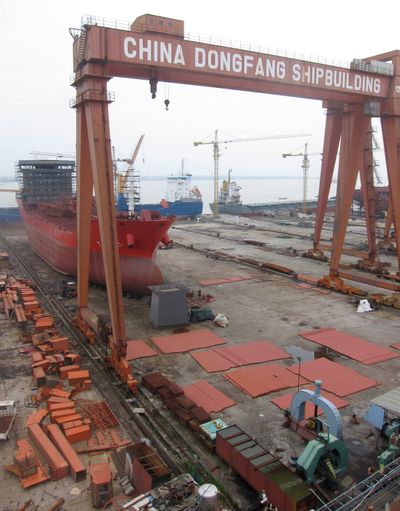Growth slowing for No. 2 economy

BEIJING – China’s economy appears to be weakening more rapidly than official statistics would suggest, raising fears of a painful slowdown that could be felt around the globe.
Second-quarter gross domestic product statistics to be released this week are expected to show growth of around 7.5 percent compared with the same period last year, according to analysts’ estimates. That would be the slowest pace since the depths of the global financial crisis. But government data are widely believed to understate the extent of China’s woes.
Other indicators point to a much sharper decline, economists said. Record amounts of coal and iron ore are piling up at depots, signaling waning demand for electricity and building materials. Excavators and other heavy equipment are being idled or sold at deep discounts as housing construction has stalled. The demand for diesel, needed to power those machines, has been flat for six months. Shipyards have laid off thousands of workers, and half-built vessels have been left to rust.
On Sunday, Premier Wen Jiabao warned of “huge downward pressure” on the world’s No. 2 economy, one of the strongest admissions yet that China’s top leaders are worried about the recent deceleration. The country’s central bank last week unexpectedly cut bank lending rates in a bid to stimulate lending. China’s trade minister said last month that the country would be “lucky” to meet its growth targets for imports and exports this year, describing the environment as “grim.” Trade numbers for June, released Tuesday, came in lower than expected, according to media reports.
Industrial data point to a decline that government growth figures wouldn’t fully reflect, according to economists who are downgrading their forecasts. Local officials throughout China are suspected of padding growth estimates to meet targets set by Beijing to boost their chances for promotion.
“Recent economic data, including steel production and corporate profits, have continued to weaken visibly,” said Yiping Huang, an economist for Barclays. “There is a renewed perception that the real economy is much weaker than is suggested by official statistics.”
Meanwhile, Chinese manufacturing activity has been slowing, a sign of slackening demand from Europe and the U.S., China’s biggest markets for factory goods.
Alan Wang, a footwear trader in the southern city of Shenzhen, said sales this year are down a third. His mostly French and Spanish customers are taking as long as four months to pay their bills. Wang said one of his local suppliers has already closed. Another is on the brink after a U.S. buyer filed for bankruptcy and couldn’t pay for a $1.1 million order for tennis shoes.
Such weakness is unwelcome news for a world economy already weighed down by troubles in the eurozone. China powered through the 2008 financial crisis and has delivered blistering GDP growth during much of the past decade. Now analysts are projecting that the growth rate in 2012 will struggle to reach 8 percent – a symbolic target that officials are loath to miss.
Developing nations including Brazil have already seen exports of oil, iron ore and other commodities to China slump. Luxury jewelers in Hong Kong are complaining about a decline in free spenders from China.
The slowdown has also crimped earnings at U.S. corporations that had been expanding in China, including Caterpillar Inc., Nike Inc., McDonald’s Corp. and Yum Brands Inc., which operates KFC and Pizza Hut.
With a once-in-a-decade transition of top leadership looming in China this year, stability is paramount. Calls are growing for officials to buttress the economy through policy tinkering and government stimulus.
But China’s leaders must proceed carefully. The nation is still suffering the fallout from the last round of intervention following the 2008 global crisis. To keep the economy humming, Beijing spent billions on public works and encouraged banks to lend – easy credit that fueled a housing bubble and a surge of borrowing by local governments.
Some economists think Beijing will successfully steer the country back on track, perhaps as soon as the third quarter of this year. Others aren’t so sure.
“The landing of China is becoming harder rather than softer,” New York University professor and longtime bear Nouriel Roubini recently told Bloomberg. “It’s the perfect storm. You could have a collapse of the eurozone, a U.S. double-dip, hard-landing of China, hard-landing of emerging markets and a war in the Middle East. Next year could be a global perfect storm.”